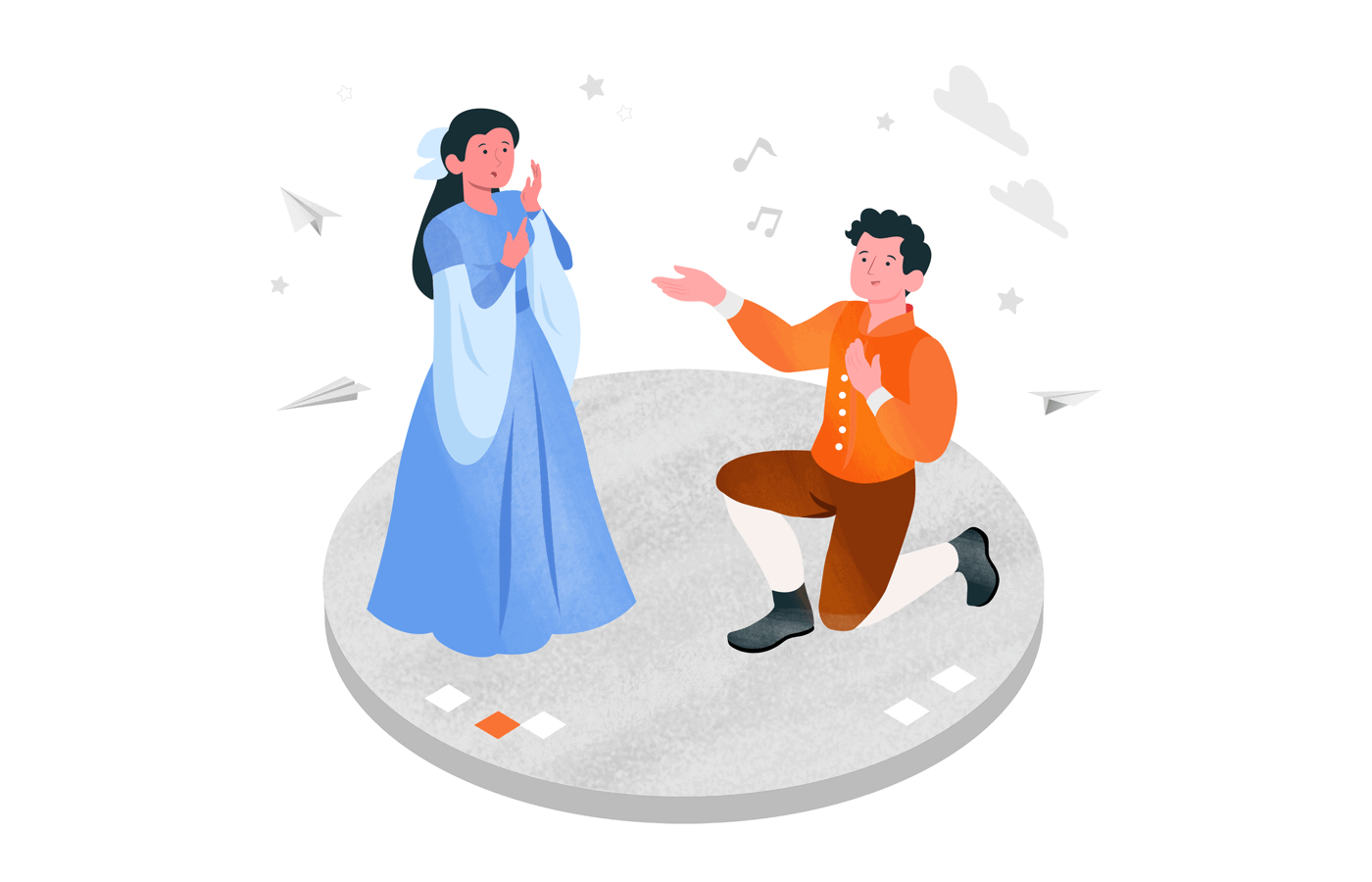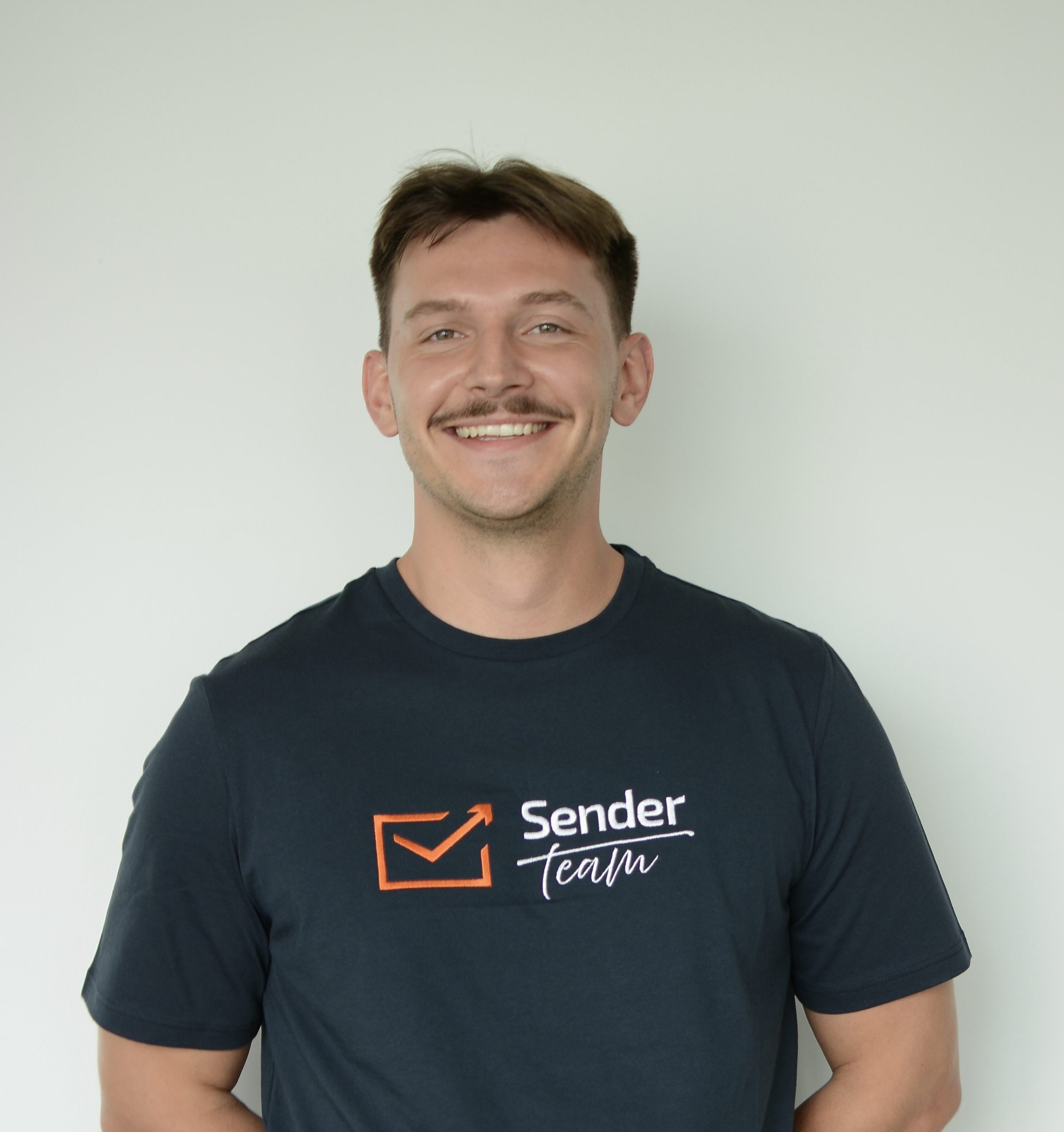Losing customers is disheartening, but don’t lose hope yet. In fact, it’s the best time to double down your email marketing efforts through targeted winback campaigns.
Such campaigns nudge past customers and reignite their interest in what you have to offer. At Sender, we’ve tested countless win-back strategies to understand what truly works.
Today, we’re sharing the secrets and best win-back email examples that reduce customer churn and have brought customers back. Let’s start.
What is a Win-back Email?
A win-back email campaign is a way to re-engage inactive customers. These emails tap into human psychology—using FOMO, incentives, or personalized recommendations to make them curious and bring them back.
Think of such emails as a friendly nudge. A well-timed email—whether it’s a “We Miss You” message, a special offer, or a helpful reminder, is sometimes all it takes to get their attention.
Here’s why such marketing emails should be part of your strategy:
- Cheaper than acquiring new customers. Keeping a customer costs 5x less than getting a new one;
- Great engagement booster. Not all inactive customers are lost. Some just need a reason to return;
- They drive real results. Win-back campaigns increase sales. The probability of selling to an existing customer is 60-70% against 5-20% for a new customer.
When to Send Win-Back Emails?
Whenever we’re planning for win-back campaigns, we always remind ourselves that timing is everything. Send come back emails too soon, and it might feel pushy. Too late, and they’ve probably moved on.
The trick is to time it based on behavior—when customers are most likely to notice (and care about) your message.
Here’s when to reach out with a win back flow for the best chance of revival:
- After a period of inactivity. If a customer hasn’t opened an email, visited your site, or made a purchase in 30, 60, or 90 days, they may need a reminder. Send an email with a subject line like, ‘It’s been a while, [Name]—let’s catch up! Here’s 15% off just for you’;
- Post-purchase lull. Some customers buy once and forget about you. An email like ‘Loved your last order? Here’s a special offer on your next one!’ can turn one-time buyers into repeat customers;
- Abandoned cart or browse activity. If they were interested, but something stopped them from buying, send a gentle nudge. An email with a subject line like ‘Your cart is waiting’ with a special offer can push them to complete the purchase;
- During seasonal or holiday promotions. A holiday or special event can be the perfect excuse to re-engage lapsed customers. Plan a campaign that sends a special discount or gift their way, nudging them to come back and save;
- After a negative experience. A bad review or poor experience is the best time to reach out. It’s an opportunity to repair a relationship. Send an email like, ‘We’re sorry we missed the mark. Here’s how we’re making it right’.
Remember, it’s all about the right moment and hitting their inbox when they’re most likely to care. Now let’s look at some examples to give you ample ideas of such moments throughout the customer journey.
14 Win-Back Email Examples
Now that you know the basics, let’s look at some real-life examples of customer winback emails to inspire you to create effective future emails to engage inactive subscribers.
1. ‘We Miss You’ Email
Miss you emails remind customers and inactive subscribers about your brand, asking them to engage. An effective re-engagement email uses personalization, humor, and a compelling call-to-action to bring back lost interest.
Belgian Boys sends a warm and cheeky message to remind loyal customers about themselves:
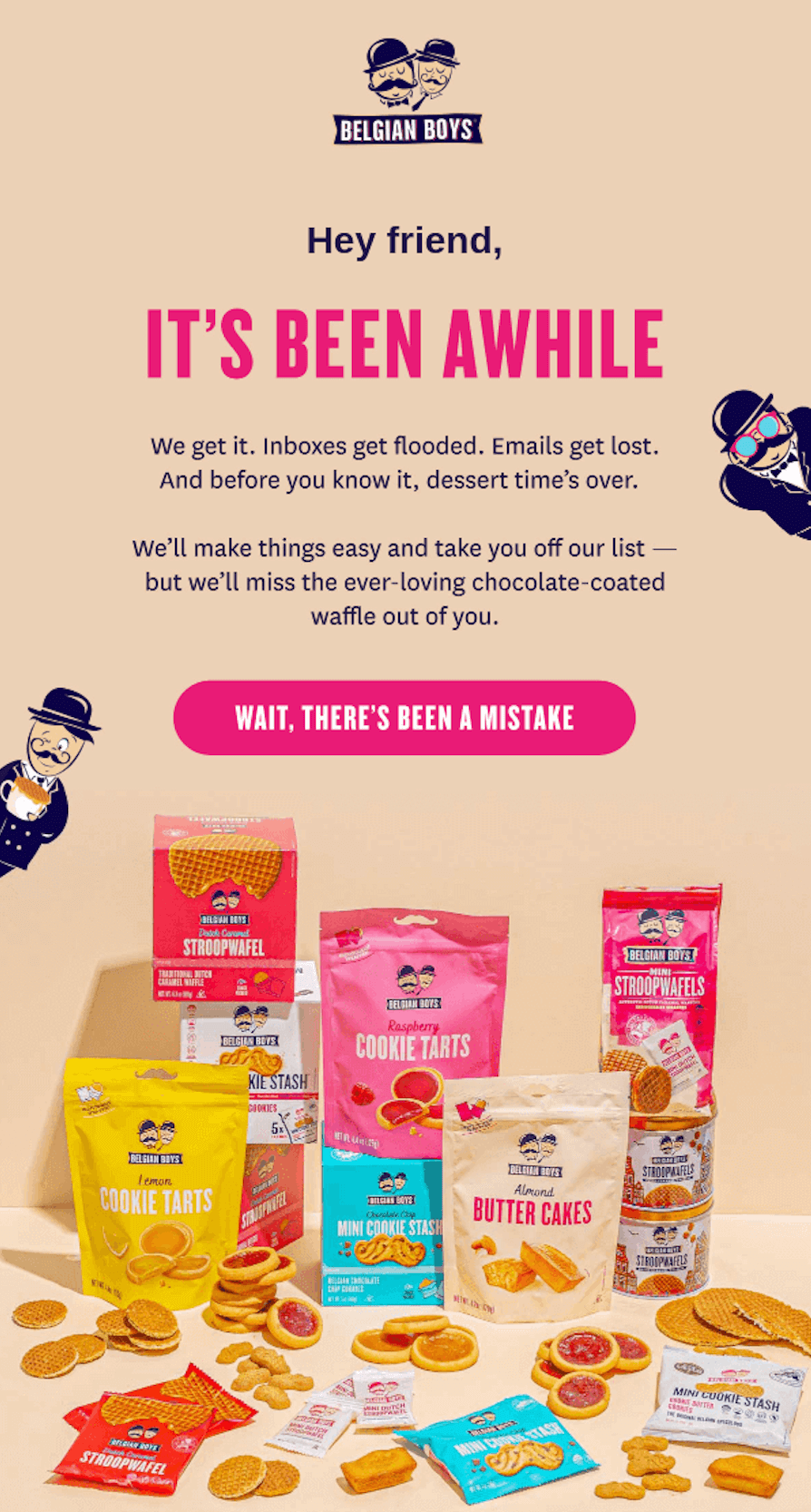
The email body is lighthearted and tastefully uses humor by saying they’ll “miss the chocolate-coated waffle” out of the reader. This makes the brand feel human.
The bold CTA button—”Wait, There’s Been a Mistake”—adds intrigue and reverses the typical unsubscribe dynamic, making users think twice before leaving. The layout is clean, with a focus on customer loyalty rather than bombarding offers.
2. Abandoned Cart Follow-Up
Abandoned cart follow-up emails remind visitors of the products they left behind and nudge them towards finishing their purchase.
Good abandoned cart emails, like the one below by Blueland, balance urgency, reassurance, and a compelling reason to return.
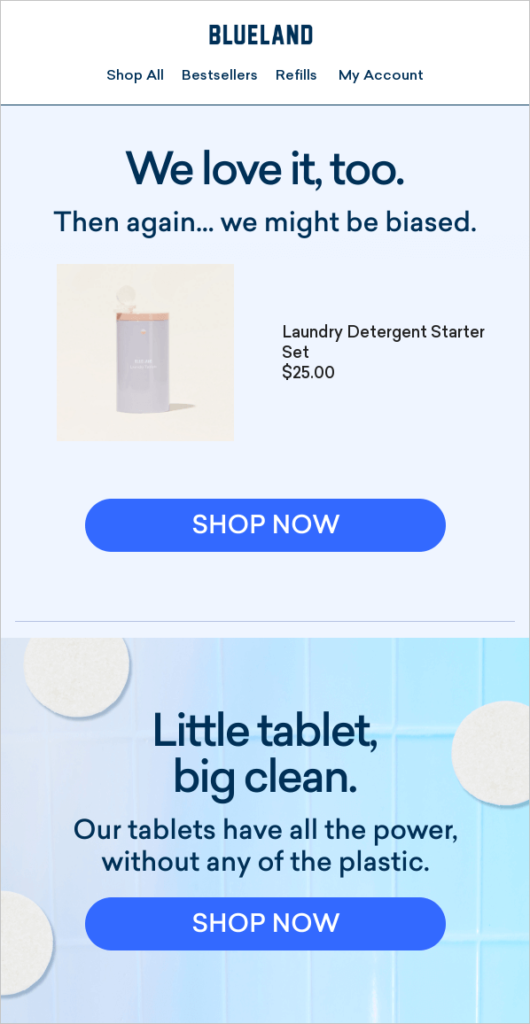
Blueland took a conversational approach with this email. Instead of a generic “You left something behind,” they open with “We love it, too. Then again… we might be biased.”
This makes the email feel personal rather than pushy. The product is displayed with a clean, minimalist aesthetic, reminding the reader about their cart. The bold “Shop Now” CTA button is hard to miss, offering a frictionless way to return to checkout. They could’ve added an incentive like free shipping or an extra discount, though.
3. ‘What You’re Missing” Email
These emails are designed to create FOMO (fear of missing out) and encourage users to take quick action.
Brands use such emails to promote ongoing offers, loyalty programs, or a final call. Here’s a great email that uses a GIF to make readers curious.
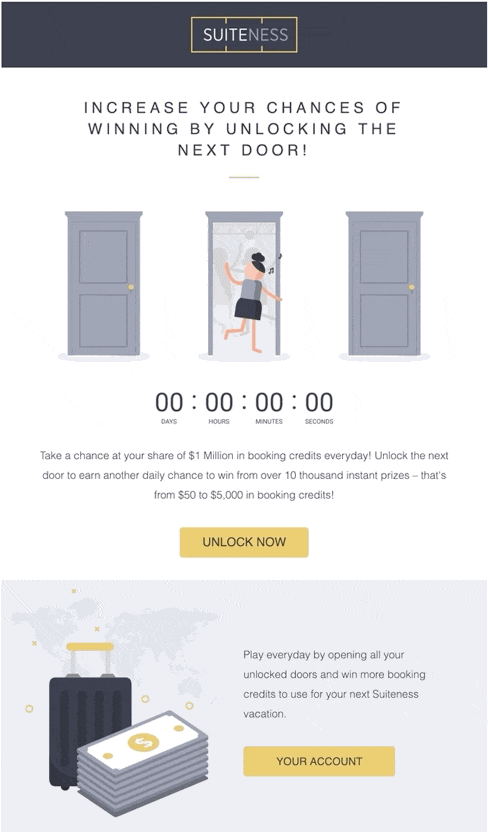
The animated GIF showing a person unlocking a door visually reinforces the concept of missing out on prizes. The countdown timer intensifies the urgency, making it clear that every second counts. The email doesn’t just say, “You’re missing out”—it shows it through dynamic motion and compelling copy.
Mention of a pool of $1 million in booking credits adds a high perceived value, making participation feel worthwhile. The “Unlock Now” CTA in gold stands out, making it easy for recipients to act instantly.
4. Feedback Request Email
A feedback request email is designed to ask visitors about their opinions (and understand the reason for their inactivity). Usually, such emails have a direct tone with a clear incentive for everyone who chooses to offer their feedback.
But some brands love to add a twist to maximize participation. Have a look at the following email by Grind that turned a simple survey into a sweepstakes.
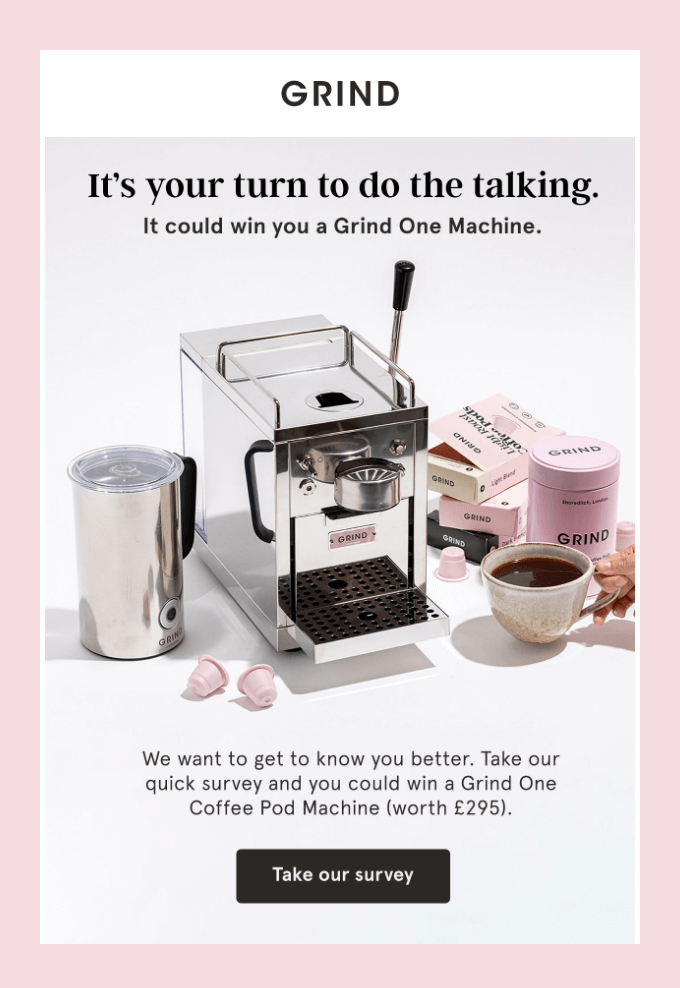
Isn’t this email exciting? The headline — ‘It’s your turn to do the talking’, immediately shifts the focus onto the recipient. The added hook—”It could win you a Grind One Machine”—creates a clear incentive, making participation in the feedback survey more enticing.
The sleek, product-focused imagery reinforces the value of the reward, while the bold, simple CTA button (“Take our survey”) ensures there’s no confusion about what to do next.
This email works because it balances a clear request with a compelling incentive, ensuring recipients feel motivated rather than obligated to respond.
5. Offer an Irresistible Deal
Discount codes and incentives are the best ways to win back lost customers. Offering an incentive can be a great motivator for customers thinking about buying from you again.
This incentive needn’t necessarily be a discount code. You can offer them other incentives, such as bonus gifts, extra reward points, free shipping, free consultation, and more.
For example, Google sent out an email announcing a free custom email address to users for three months.
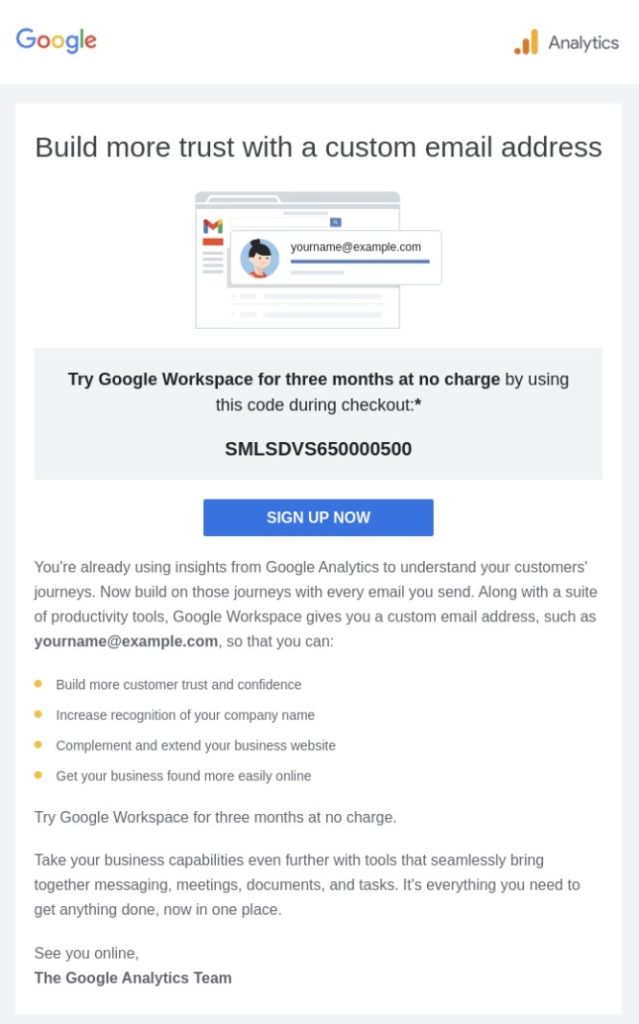
Google is well aware of the importance of having custom email addresses for businesses. For customers, getting a custom email address for free for three months is a good deal to miss. The email also mentions the importance of having a custom email address, thereby convincing the customers to grab their offer.
6. Recommend Various Products
Showcase your products or services to inactive customers and encourage them to buy from you with personalized product recommendations. Help your customers discover new things and create a sense of excitement that can inspire them to check out your products and make a purchase.
You will be surprised that sharing product recommendations in your email messages can increase your click-through rates by 840%.
Here is an example of an email sent by Laura Mercier, a beauty products brand, to its customers. Notice the product recommendations the brand shares with the customers based on their frequent purchases.
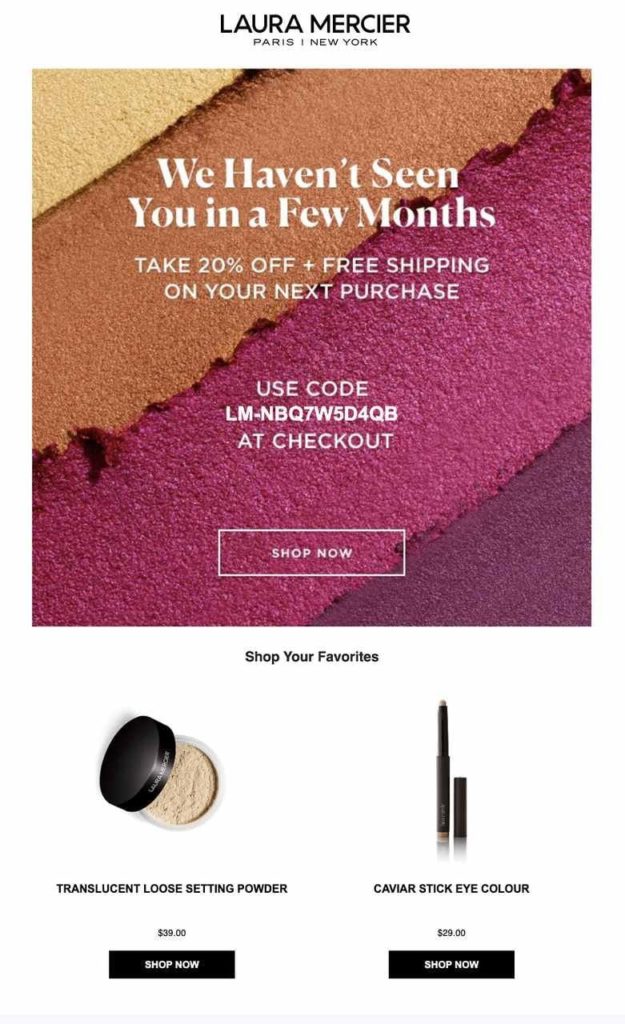
Laura Mercier keeps its email simple as inactive customers wouldn’t be willing to read a lot of copy. The email politely asks the customers to revisit their website and offers personalized product recommendations. Besides, email offers customers tangible incentives to impact the customer’s purchasing decisions.
7. Educate about Pausing and Cancelation Options
If you’re a subscription-based business, educating customers about your pricing plans and how each of them works is the best win-back strategy to follow.
By informing customers about pausing and cancellation options, you give them knowledge and control over their subscription or membership. This empowers them to make informed decisions, and they may be more likely to continue their subscription or membership in the long run.
For instance, Netflix always assures regular and disengaged customers that they can cancel their subscriptions at any time if they choose to reactivate their accounts.
Struggling to reconnect with inactive customers? Win them back with emails! Free email templates, drag-and-drop builder, effortless campaigns, automation—all in one tool.
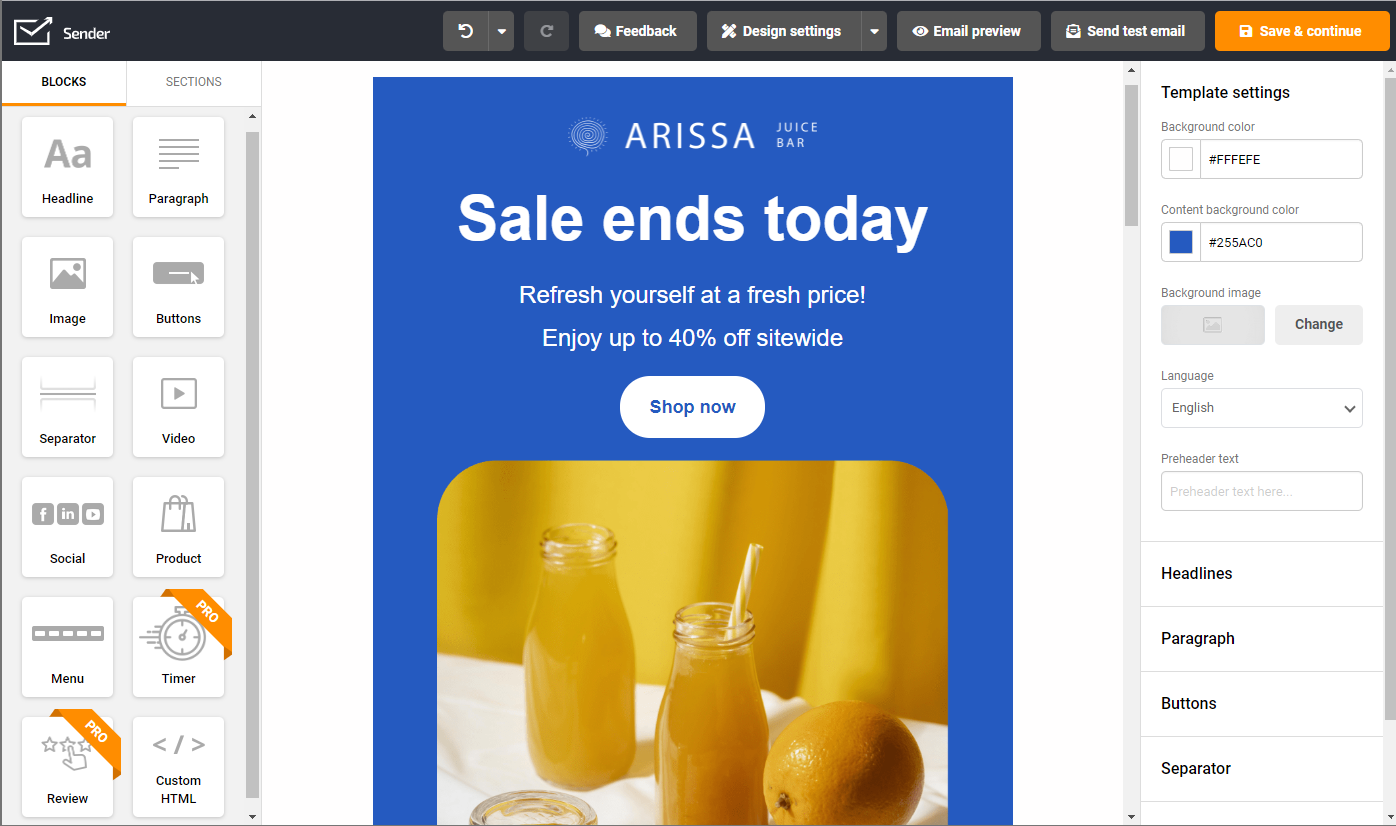
8. Mention the Offer in the Subject Line
Email subject lines play a crucial role in increasing open rates. In fact, 33% of customers admitted that they open emails because of these catchy subject lines.
Mentioning discounts in the subject lines is another excellent way to motivate customers to open your emails. It helps your messages stand out, compels your customers to view them, and delights them into making purchases.
Check out this email from Barista & Co, a UK-based coffee roaster offering its subscribers a treat. The minimal design gives this email message a clean look. Further, it piques the recipients’ curiosity by not revealing the offer right away.
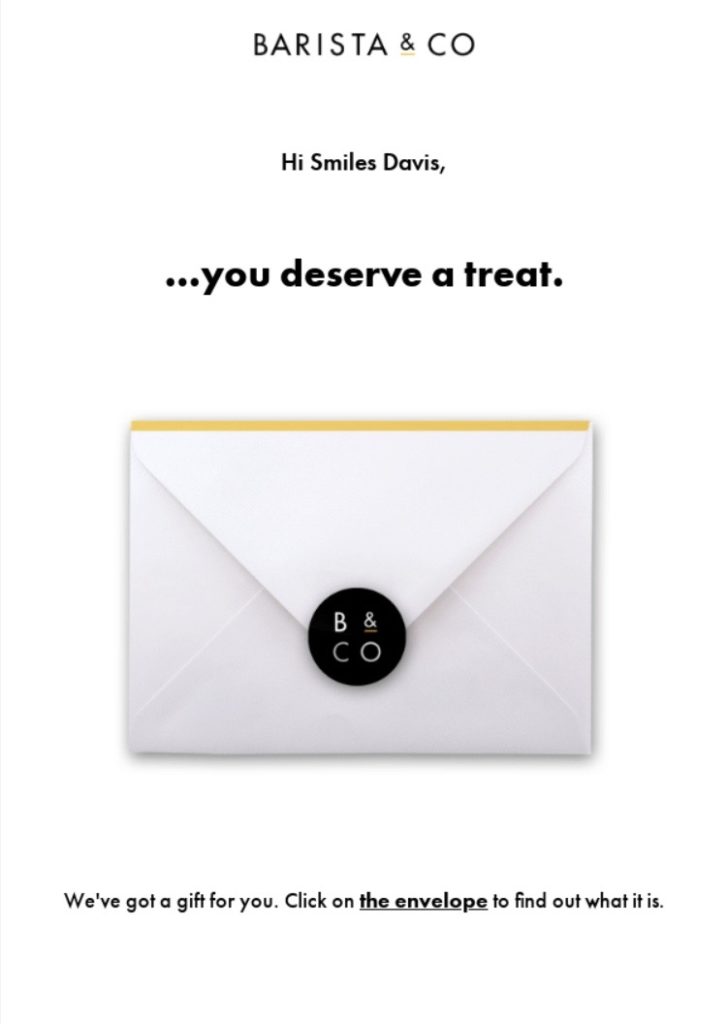
Barista & Co. uses an engaging phrase ‘free gift’ in the subject line that acts as a very compelling CTA and encourages customers to open the email. The email lacks fluff and delivers the intended message without beating around the bush.
9. Re-engage Inactive Customers with a Seasonal Campaign
Leverage the timing and context of a particular season, event, or holiday to reconnect with past customers by talking about the season. Align such email campaigns with the need of the hour to offer seasonal customers compelling reasons to come back.
For example, Freshly, a meal delivery service, announced a $60 off a week before its Black Friday sale. In its email, Freshly explained how this discount would be divided over 4 orders, thus encouraging the customers to shop throughout the week to be eligible for the discount.
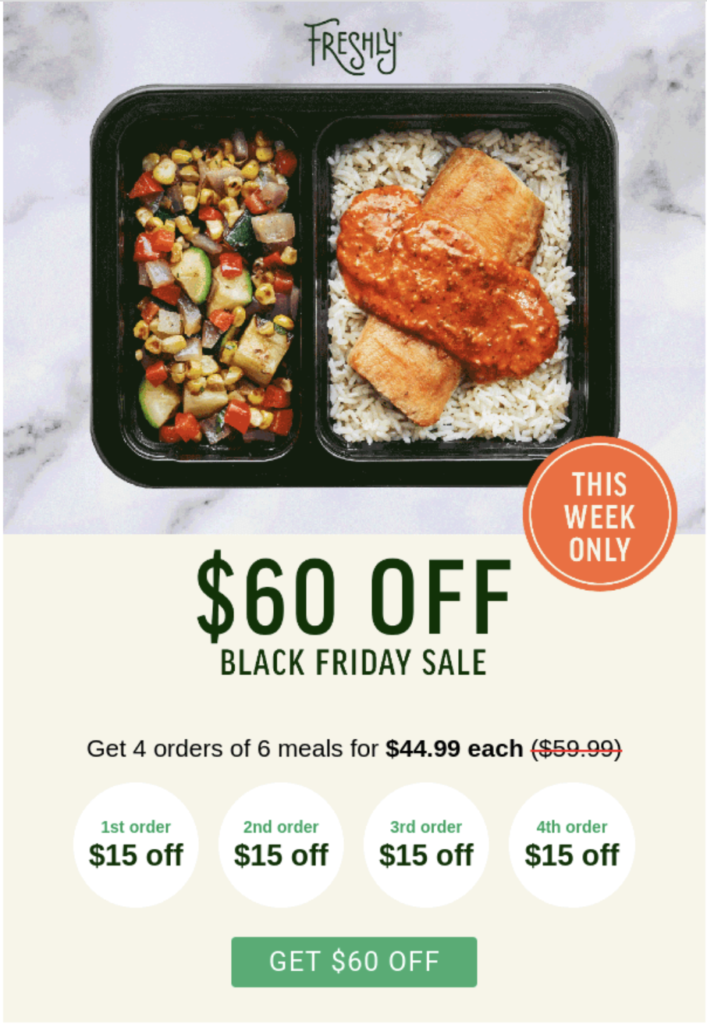
Freshly diverts its customer’s attention to its offering before the Black Friday sales actually begin. It keeps its customers engaged with this amazing offer, thereby remaining on top of its customer’s minds during the sale season.
10. Send Follow-Up Product Recommendations
Sending follow-up product recommendations to customers is yet another powerful way to personalize their shopping experience and increase the likelihood of a repeat purchase. Analyze your customers’ purchase history and browsing behavior to send targeted follow up email with product recommendations.
For example, Good Eggs sends emails containing new product recommendations to customers.
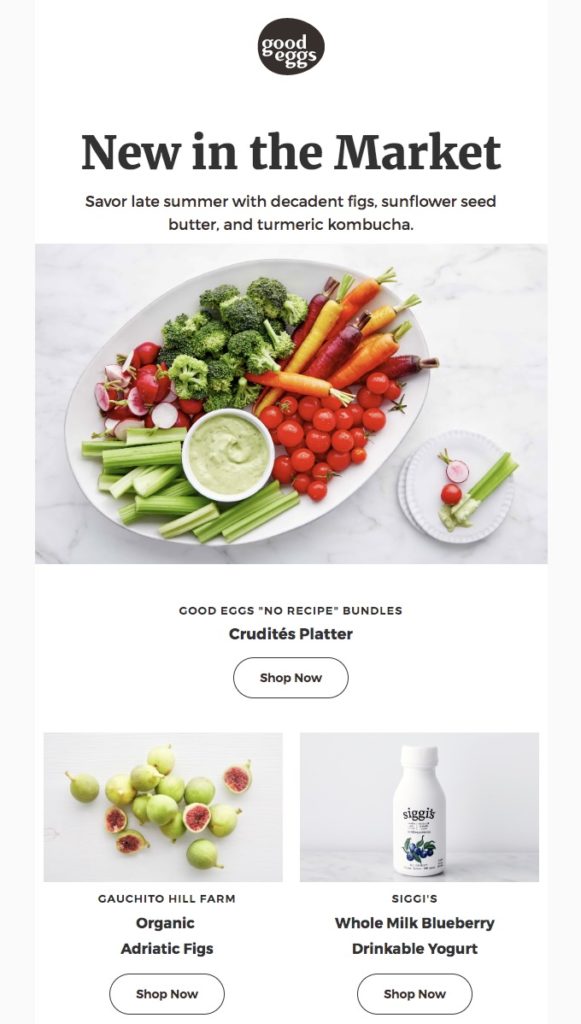
The email is personalized with recommendations based on their past browsing and purchase history. A clean and minimal layout keeps the focus on the products, tempting the user to purchase.
11. Invite Customers to Visit Your Stores
Inviting customers to visit your stores offers you an excellent chance to revitalize their interests and foster a sense of personal connection. It allows you to highlight new products, limited edition collections, and more to generate curiosity among customers.
For example, Starbucks sent out an email informing its customers about the happy hour at their store. In other words, Starbucks invited its customers to visit their stores and grab exclusive deals on drinks, food items, and more.
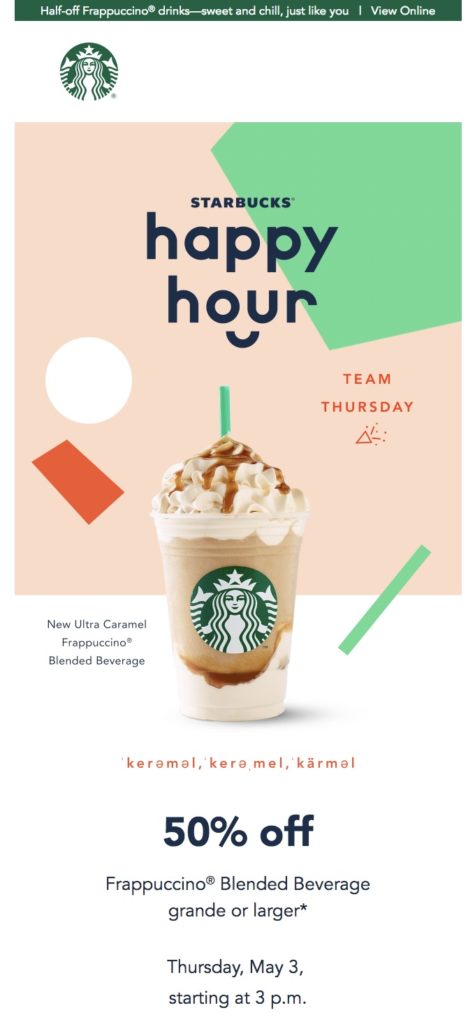
This email is the best way to inform customers about the exclusive benefits and experiences Starbucks has in store for them.
Starbucks creates an opportunity for its customers to rediscover its brand, build stronger relationships, and enhance its brand-building process. This email itself can help the brand attract new customers while encouraging existing customers to visit their stores during happy hours.
12. Limited-Time Offer Email
One of the oldest selling tactics, creating urgency, still manages to encourage customers to make purchases. The feeling of FOMO plays a significant role in driving customers to make decisions instantly. Create a sense of urgency in your emails by setting deadlines, offering hard-to-get deals, or solving an unpleasant problem.
Here is an offer from Birchbox, a beauty subscription box. The brand announced a freebie item on all purchases above $29 for a limited duration. This urgency pushes their disengaged customers to take immediate action.
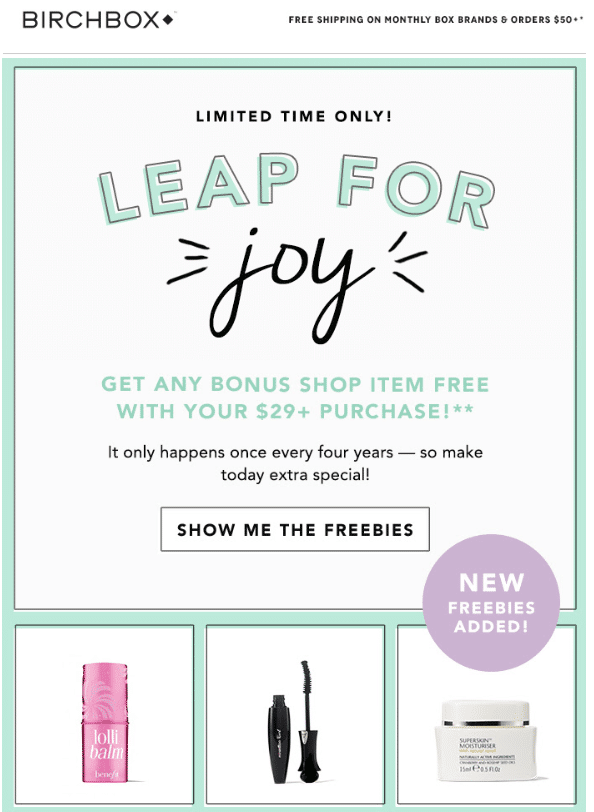
The freebie product incentive acts as a strong magnet for attracting customers. And this deal is available for a limited time, creating FOMO among customers leading to quicker purchases.
13. Promote Free Shipping
Did you know that 49% of customers don’t complete their purchases because of additional costs, such as shipping fees, taxes, and more? Free shipping allows you to get back to these customers and encourage them to finish their checkout process.
Send out an email announcing free shipping to your customers, removing a potential barrier to their purchases. Craft your subject line to explicitly mention this offer.
Design Within Reach, a modern furnishings and lighting store, sent out an email announcing free shipping across their entire store for a certain time period. Besides free shipping, the store offered an additional discount of 15% on certain items. Free shipping and the discount offer is too good to miss.
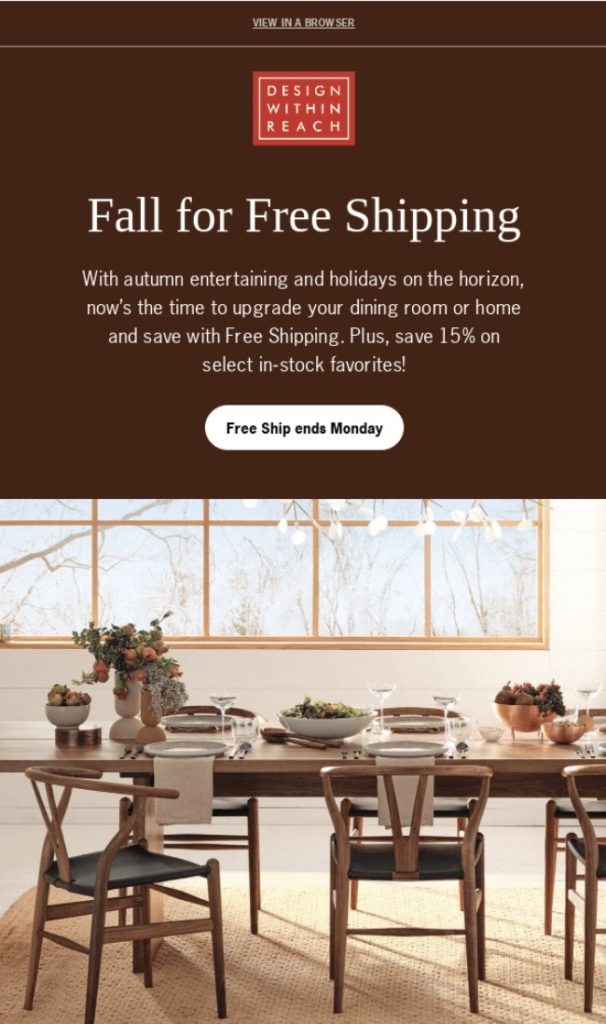
The email subtly mentions the availability of the deal and thus creates a ticking clock to encourage customers to place their orders. It gives customers an option to choose from a variety of their offerings.
14. Re-Engagement Survey Email
Re-engagement survey emails invite inactive subscribers to share their opinions in return for an incentive. The goal is to make the recipient feel valued and heard and in the process revive interest.
Here’s a good example of an email by Graza that looks more like a message from a friend than a marketing team.
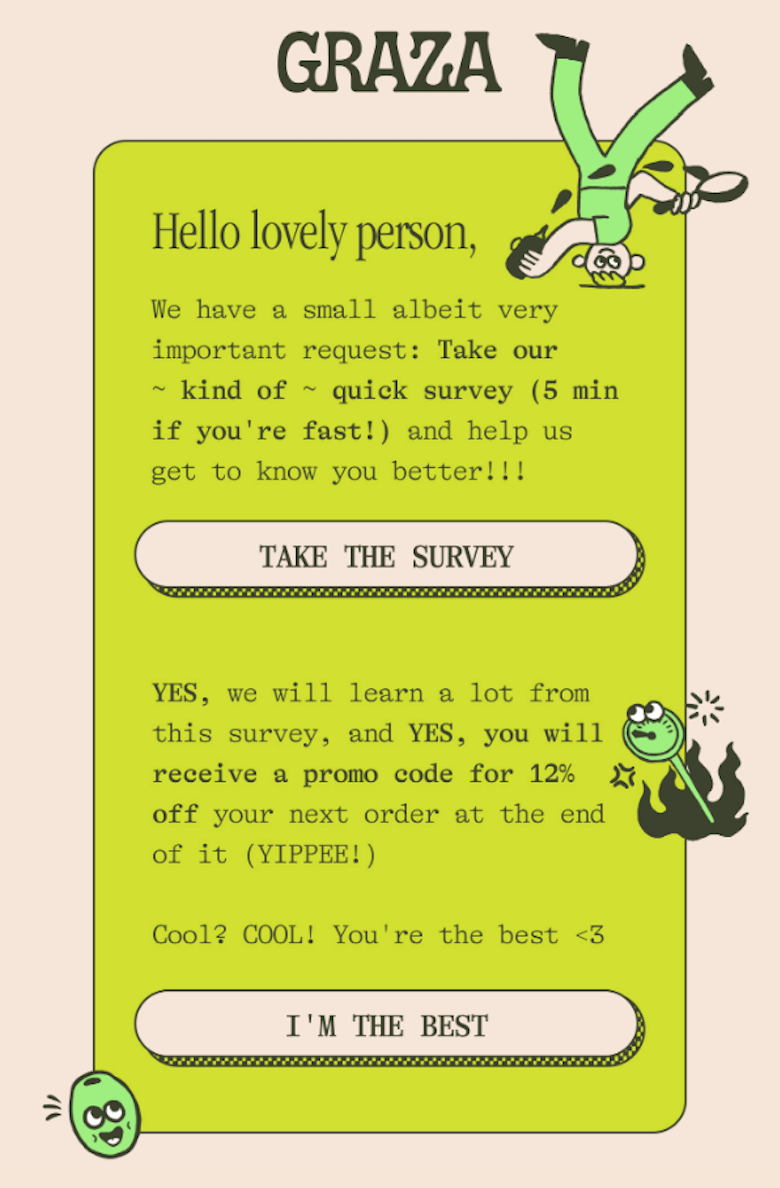
The greeting, ‘Hello lovely person’, instantly makes the reader feel appreciated, while the self-aware phrasing (“Take our ~ kind of ~ quick survey”) keeps things light.
Bright, friendly colors reinforce the brand’s quirky identity, making the experience feel fun rather than transactional. The CTA buttons, labeled “TAKE THE SURVEY” and “I’M THE BEST”, inject personality and are unmissable.
The promise of a discount code at the end of the survey gives recipients a tangible reason to participate.
Key Elements of a High-Converting Win-Back Email
A win back email sequence isn’t just about saying “We miss you”. It’s about knowing what to say, how to say it, and when to send it to give customers a compelling reason to re-engage.
Here are the key elements that make ecommerce win-back emails successful:
- Personalization. Address customers by name, but don’t stop there. Use personalized recommendations, exclusive discounts, or tailored messaging to show them you understand their needs;
- Timing. Analyze customer behavior to find the best moment to send a customer win back email—whether it’s 30, 60, or 90 days of inactivity. For example, sending a reminder just before a subscription renewal or a seasonal sale;
- Attention-grabbing subject lines. Your subject line is your first (and sometimes only) chance to make an impact. Keep it short, engaging, and curiosity-driven. For example, ‘Is this goodbye? Here’s a special offer if you stay’;
- Relevance. Segment customers based on purchase history, customer engagement level, or preferences to send highly relevant win-back messages. For example, an inactive customer who bought sneakers before should get a different message than someone who browsed but never purchased;
- Clear and actionable CTA. Don’t leave them guessing. Your CTA should tell them exactly what to do next, using a visually appealing button and concise copy. For example, “Come Back & Save 20%”;
- Ask for feedback. Some customers stop engaging because of frustrations or unmet needs. Ask them for feedback and show them you’re listening;
- Follow up elsewhere. If email alone isn’t working, extend your re-engagement efforts to SMS and social media through retargeting ads. Remember, customers are everywhere—your outreach should be, too.
